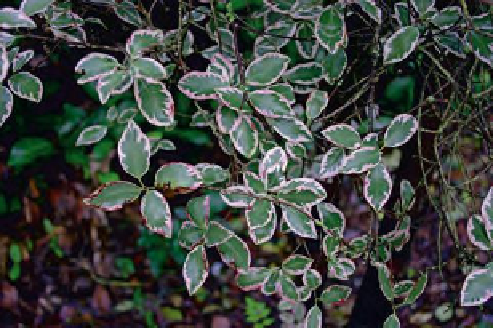Agriculture Reference
In-Depth Information
temperatures slow down photosynthesis and
therefore slow the growth rate at this time of year.
To provide the optimum temperature conditions,
glasshouses can be heated in winter using a range of
methods such as thermostatically controlled electric
heaters or paraffin burners together with insulation
such as bubble wrap. To reduce temperatures which
are too high, shading using blinds, netting or washes
applied to the glass, ventilation or damping down
(applying water to floor surfaces to evaporate) can be
employed.
Water
Figure 9.3
Chlorosis due to magnesium defi ciency in
a lemon
Water is required in the photosynthesis reaction
but this represents only a very small proportion of
the total water taken up by the plant. Water supply
through the xylem is essential to maintain leaf
turgidity and retain fully open stomata for carbon
dioxide movement into the leaf. In a situation where a
leaf contains only 90% of its optimum water content,
stomata will close to prevent further water loss and
will reduce carbon dioxide entry to such an extent
that there may be as much as a 50% reduction in
photosynthesis. Changes in leaf angle in a wilting
plant also reduce light interception. Wilting is most
often associated with lack of water but can also be
seen in waterlogged plants (see p. 116). A visibly
wilting plant will hardly be photosynthesizing at all,
therefore it is essential that plants should be supplied
with the correct amount of water if the rate of
photosynthesis to be optimized.
Figure 9.4
Variegated leaves in
Pittosporum
tenuifolium
'Silver Queen'
Mineral nutrients
harvested or the grass mown and removed as in
these situations nutrients are not returned to the soil.
Similarly plants in containers will eventually deplete
the nutrients in the growing medium, so these will
need to be replaced by feeding.
Minerals are required by the leaf to produce the
chlorophyll
pigment that absorbs most of the
light energy for photosynthesis. Production of
chlorophyll must be continuous, since it loses its
efficiency quickly. A plant deficient in iron, nitrogen or
magnesium, especially, turns yellow (
chlorotic
) and
loses much of its photosynthetic ability (Figure 9.3).
Variegated
leaves (Figure 9.4),
where parts of the
leaf are pale or even white and are therefore lacking
chlorophyll, have a lower rate of photosynthesis
overall and therefore the plant will have a slower
growth rate. Some variegated plants are prone to
'reversion' where the variegation is lost. The stronger
growing green leaves can rapidly take over the plant
and should be pruned out as soon as they appear if
the variegated form is to be retained (see p. 266).
Supplying the correct balance and amount of nutrients
through application of fertilizers is especially important
in the vegetable plot and in lawns where plants are
The law of limiting factors
The
law of limiting factors
states that the factor
in least supply will limit the rate of photosynthesis.
If, for example, carbon dioxide levels fall in an
enclosed system such as a glasshouse, the rate
of photosynthesis will decrease. In this situation,
increasing light levels or temperature will not be
advantageous if the carbon dioxide levels remain low.
Similarly, if there is adequate carbon dioxide and a
suitable temperature but light levels are reduced, as
in the winter, there will be no advantage in increasing
carbon dioxide levels or the temperature without
giving additional light. In fact, if any one of these three
factors (light, carbon dioxide or heat) is in short supply,
then it will limit the rate of photosynthesis even


